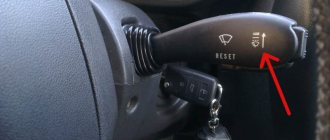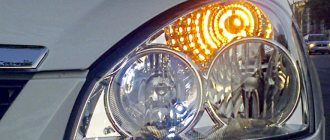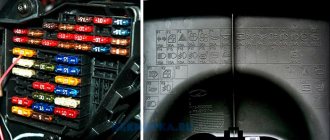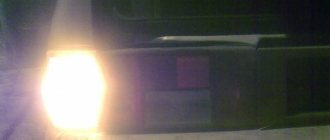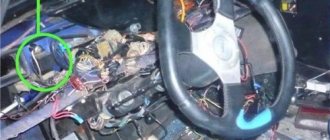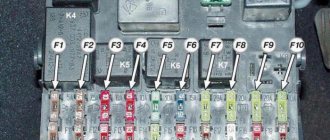Signs and causes of malfunctioning turn signals and emergency signals
These elements of the lighting system stop working due to:
- Blown fuse box in the passenger compartment. This problem occurs often. If the car is equipped with a relay that regulates the operation of lighting devices, the cause should be looked for in it. Depending on the make of the car, this part may be located at different distances from the fuses. The diagram attached to the instructions helps you find it.
- Short circuits in the on-board network. Because of this, the turn lights do not light up and the hazard warning lights go off instead. The system stops responding to user commands. To detect a breakdown, you will need a multimeter. The driver must understand the electrical circuit.
- Failure of the lighting source. In this case, replace the burnt out light bulb.
- Broken wiring. This is what owners of outdated VAZ car models face. If the wires are laid in places where there are moving parts, the braid will fray over time. The integrity of the electrical circuit section is compromised.
- Failure of the turning light control element or steering column switch. In this case, a thorough diagnosis of the control buttons is required.
The following signs help determine the presence of malfunctions in the optical system of the machine:
- The turn signals are on continuously. The symptom appears when the relay breaks down, in particular its electromagnetic component. It often gets stuck in one position, causing it to be unable to return to its original position.
- The blinking frequency of the turning lights has changed. The source of this malfunction is not only the relay, but also the wrong type of light bulb. When purchasing new lighting products, take into account the value declared by the car manufacturer.
- The optical system is not functioning. Not only the lights do not light up, but also the indicators on the center console. The clicks that occur when the indicators are turned on are not observed. There are many reasons for such malfunctions.
Machine breakdowns that preclude further operation
In turn, vehicle malfunctions that completely prevent its further movement are divided into two groups:
- Damage to the steering that does not allow you to fully control the car.
- The brakes are faulty and the vehicle is not braking.
These are serious car malfunctions that do not allow you to fully drive the vehicle. For example, the cause of a steering failure may be a faulty steering rack or broken steering tips, which is why the car does not respond to changes in the position of the steering wheel.
In most cases, brake failure is caused by a broken brake hose. Which leads to a drop in pressure and weakening of the brake pedal. In this case, braking is carried out due to the operation of a single circuit and such braking is not effective.
Self-diagnosis of car lighting devices
There are several situations in which you can determine that optics need diagnostics:
- The turns do not flash, but light up. Such a malfunction indicates the failure of the relay, in particular, we are talking about its electromagnetic component. The electromagnet itself could close in one of the positions, as a result of which it cannot return to its initial state.
- The turning lights flash very quickly or very slowly. In this case, the problem may lie not only in the relay. In some cases, this type of malfunction occurs when the driver uses inappropriate lighting sources. So when purchasing new light bulbs, you need to make sure that they correspond to the rating set by the car manufacturer.
- The optics don't work at all. That is, the turning light bulbs do not flicker, and the corresponding indicators on the dashboard also do not light up. In addition, there are no characteristic clicks that appear when turning on the turning lights. With such symptoms, there can be many reasons for the problem; we will tell you more about their diagnosis below (the author of the video is the Steel Horse channel).
As for diagnostics, it is performed in several stages:
- First of all, you need to make sure that all sensors and indicators on the device are working. If they do not function, then it is necessary to diagnose the safety devices.
- If all devices are operating in normal mode, then you next need to turn on the light alarm button and diagnose all light sources in the headlights. That is, check the front, rear, and side (if any) lights.
- If the alarm does not function when activated, you need to check the functionality of the relay, and also check the power supply at the terminals. To do this, remove the relay from its mounting location, and then, using a test light, connect one of its contacts to the installation site (to the positive), and the other to the car body or battery. There is no need to turn on the ignition. If there is no power, then most likely the reason lies in a failed safety device, a broken hazard warning button, or a damaged electrical circuit. Also, the essence of the problem may lie in poor contact in the connecting plugs.
- If there is a plus on the contacts, then try shorting the two relay terminals using copper wiring. If all electrical circuits, as well as the connection plugs, are working properly, then all turn signals should light up. In this case, the fault must be looked for in the relay.
- If the lights do not light up after the steps you have performed, then most likely the cause of the malfunction lies in the emergency light control button. However, in practice this happens quite rarely; there is often a short circuit in the circuit. By the way, it is a short circuit that can lead to a breakdown of the relay, therefore, before replacing the failed element, you need to eliminate the short circuit.
- If the emergency signal is functioning, this indicates that the safety devices and relays are working; accordingly, you need to start diagnosing the button itself. First of all, you need to diagnose the positive terminal, as in the case of checking the relay, while the ignition, as well as the hazard warning button, must be activated. If the diagnostics showed that there is no plus, this indicates that the button itself needs to be checked in more detail. Remove it from its seat and check the connection circuit. If there is no power, then you need to look for a break in the wiring from the tidy to the button itself. If there is power, then you will need to short-circuit the terminals at the installation site, the ignition does not turn off, after which you need to activate the direction indicators (on either side). When the lighting sources are turned on, the control button must be replaced, but if there is no power, then you need to check the power in the emergency relay. If there is no power, the problem most likely lies in a break in the connecting electrical circuit from the control key to the block with safety devices.
Timing belt
Unfortunately, the times when automakers universally used a chain drive for the gas distribution mechanism have sunk into oblivion. For the sake of cost reduction, as well as manufacturability and ease of assembly, a belt is increasingly being used in such a critical unit. Of course, this solution also has some advantages - reducing engine noise, but its failure can have fatal consequences. The fact is that at the initial stage, when such technology was just beginning to be introduced, there were other arguments in its favor. In particular, at that time there were no engines designed according to all the canons of downsizing, which is why a sufficiently voluminous combustion chamber made it possible to exclude their contact with the pistons even when the valves hung in the open position.
In addition, the chain also required regular maintenance, gradually stretching during operation, which also forced one to monitor its condition and, if necessary, replace it. So in terms of convenience, there was practically no difference between these drive mechanisms.
In addition, the belt mechanism is equipped with an automatic tensioner, so there is no need for systematic tightening. On inexpensive cars you can still find engines in which a broken belt does not damage the valves or cylinder-piston group. However, it is worth remembering that in the event of such a breakdown, it will no longer be possible to start the engine.
Over the years, the situation has changed; in pursuit of additional power and efficiency, new models have been developed in which mismatch in the operation of the piston and valve mechanisms leads to their serious damage and the need for major repairs. In addition, in some cases, engine overhaul may not be provided for by the manufacturer at all, as, for example, in the PT Cruiser car.
In addition, for a discontinued model, it is almost impossible to find the necessary spare parts. So, if the regulations require replacing the belt, rollers and tensioner, for example, every 90,000 km, do not ignore this procedure.
Video
How to diagnose a faulty turn signal, see below:
Optics play an important role when driving a car - any malfunction of the lights can create an emergency situation on the road. Turning lights are no exception, they are used both to indicate the direction of turn and for emergency lighting. It is about turn signals that we will talk today in this article, and to be more precise, about their malfunctions.
The design of turning lights is quite simple - wires are connected to the lamps through a fuse and a relay. The relay is turned on by the hazard warning button or the steering column switch. As a rule, a separate relay is installed for each direction of rotation, and a separate one for the emergency lights. Symptoms of malfunction vary in each individual case.
Turn signal diagram
The turn signal circuit differs from the usual one, where a relay and a fuse were used. The function of the turn relay can be performed by the central body electronics unit (CBEC), which is located under the panel next to the ECU. It receives input (negative) signals to contacts (X2-7 and X2-8) from the steering column switches and the hazard warning button. At the output, the TsBKE block forms “pluses” on the contacts (X1-14 and X1-15), which go to the light bulbs in the headlights and lanterns. The clicks of the turn signals are not produced by the relay, but by a buzzer on the unit board.
Checking the relay
Where is the Grant turn signal relay located? Everything is in the same mounting block. Marking K5.
How to replace the turn signal relay on a Lada Grant? It can be removed using a puller located in the mounting box, and then a known-good unit can be placed in the free space. If everything works with the new relay, then the problem is solved. However, even before searching for a burnt-out lamp, you can check the Lada Granta turn signal relay.
If you are faced with the fact that the turn signals on your Grant are constantly on, then this probably indicates that something is shorting somewhere. You need to test the circuit with a multimeter. Sometimes in this case it is possible to establish the influence of emergency lights and even signaling. Remember if you changed anything there before the problems with the turn signals appeared.
Another common problem is the situation when the turn signals on a Lada Granta do not work, but the emergency lights do work. It is necessary to check whether everything is in order with the emergency button. It happens that the button simply moves away. It needs to be given a normal position, and the turn signals will work.
Headlights
Everyone remembers that driving with faulty lighting devices is prohibited. However, if a partial malfunction occurs, many simply continue driving, hoping that the remaining light will be enough for them. This is a dangerous practice that, in addition to a hefty fine, can cause a serious accident, especially in bad weather.
At this point we are not even talking about the complete loss of functionality of one of the headlights, but, for example, about the gradual loss of transparency of lenses or diffusers, untimely adjustment of the light flux, as well as banal pollution.
Always check the functionality of the lighting devices, especially if you are traveling in the dark or in bad weather, carry out all routine maintenance in accordance with the recommendations, and also if there are only the slightest changes in their operating parameters. Even if it’s snowing or raining, wipe your headlights - this will significantly improve the road illumination for at least a few kilometers of your route.
Reasons for failure of turn signals and emergency lights
As you know, the circuit of direction indicators and hazard warning lights is tied, since both functions are performed by the same headlights. If for some reason the hazard lights are working, but the turn signals are not, or neither the turns nor the warning lights are on, this can lead to an emergency situation on the road.
For what reasons did these elements stop working:
- Fuse failure is one of the most common problems. If the car is additionally equipped with a relay that is responsible for the operation of these optical elements, then the problem may lie there. Depending on the car model, the relay may be located separately from the main fuse block; use the diagram to find the failed part.
- Short circuit in the system. Because of this, when turning on the turning lights, the emergency lights turn on or the optics do not respond to the driver’s commands at all. To diagnose the problem, you will need a tester, as well as the skills of an electrician.
- Failure of the lighting source. In other words, the light bulb has burned out.
- Open circuit. This problem is relevant for many car owners of older cars. If the wires are laid in a place where there are moving elements, then over time it will fray and lose its insulation, which will generally lead to damage to the electrical circuit.
- Failure of a button or steering column switch. In this case, it is necessary to carry out more thorough diagnostics of the switch, as well as the connection button.
Device
The following are involved in the operation of turn signals:
- steering column turn switch. Its function is to close the power contact of the light bulbs. For example, when you turn the switch up, one of the contacts of the light bulbs on the right side closes to the “+” of the battery. The “minus” of the light bulb is the connection point to “ground” (the common point for all headlight bulbs);
- turn signal relay. There is a regular electromagnetic relay inside the case, but it is controlled by a microcircuit. It is thanks to this element that an intermittent power supply to the coil is ensured. The second important function is monitoring the health of the lamps. The microcircuit has a feedback function, so when a light bulb burns out, it registers a decrease in the power of consumers and begins to supply power to the coil at double the frequency. If the turn signals are working properly, the lights blink approximately once per second. Most modern cars, including VAZ models, use a 3-pin turn signal relay. Accordingly, 1 contact is “ground”, 2 – power supply from the battery, 3 – output to the steering column switch;
- light indication on the dashboard. One or two light bulbs (one on each side) are connected in parallel to the electrical circuit of the main lamps. The turn signals will work without a light indication, so the system should not be considered among the possible causes of the malfunction.
Connection diagram
The simplest turn signal connection diagram.
The video discusses in detail the principle of turning on the direction indicators, as well as the role of the hazard warning button in the operation of the system.
Diagnostics and repair
All electrical equipment of a Lada Granta car must be diagnosed using multimeters and test benches. If damage is detected, the element is replaced exclusively with a known good one. The use of used parts can lead to unexpected breakdowns and incorrect operation of equipment and devices.
The electrical circuit of the Lada Granta is a complex part of the car's equipment. Diagnostic work and repair of on-board circuits must be carried out with the required tools and necessary knowledge. In the absence of the above, it is recommended to contact qualified professionals for help.
Note! Below are the shipping methods available specifically for this product. Payment options may vary depending on the shipping method.
- Cash on delivery (payment upon receipt)
- Using cards Sberbank, VTB, Post Bank, Tinkoff
- Yandex money
- QIWI
- ROBOKASSA
- Cash on delivery (payment upon receipt)
- Using cards Sberbank, VTB, Post Bank, Tinkoff
- Yandex money
- QIWI
- ROBOKASSA
- Cash on delivery (payment upon receipt)
- Using cards Sberbank, VTB, Post Bank, Tinkoff
- Yandex money
- QIWI
- ROBOKASSA
- Using cards Sberbank, VTB, Post Bank, Tinkoff
- Yandex money
- QIWI
- ROBOKASSA
- Cash upon receipt
- Using cards Sberbank, VTB, Post Bank, Tinkoff
- Yandex money
- QIWI
- ROBOKASSA
- Cash upon receipt
- Credit, installments
- Using cards Sberbank, VTB, Post Bank, Tinkoff
- Yandex money
- QIWI
- ROBOKASSA
Recently, the tuning of Lada Kalina (VAZ 1117, 1118, 1119), Lada Kalina 2 (VAZ 2192, 2194), Lada Granta (VAZ 2190, 2191) and Lada Priora (VAZ 2170, 2171, 2172) has been dominated by the minimalist style. This means that instead of tacky tuning from the 90s, the owners of these cars prefer to get rid of all the “extra” elements on the car body.
One of these elements, according to the owners of these Ladas, are turn signal repeaters on the wings. Getting rid of them is quite problematic, but on a dark-colored car they can be hidden. To do this, you need to buy tinted turn signals for Lada Kalina, Priora, Granta.
These repeaters are similar to the standard ones, but have tinted glass (or rather plastic), which makes the repeaters less noticeable on the surface of the body.
Checking the relay
Where is the Grant turn signal relay located? Everything is in the same mounting block. Marking K5.
How to replace the turn signal relay on a Lada Grant? It can be removed using a puller located in the mounting box, and then a known-good unit can be placed in the free space. If everything works with the new relay, then the problem is solved. However, even before searching for a burnt-out lamp, you can check the Lada Granta turn signal relay.
If you are faced with the fact that the turn signals on your Grant are constantly on, then this probably indicates that something is shorting somewhere. You need to test the circuit with a multimeter. Sometimes in this case it is possible to establish the influence of emergency lights and even signaling. Remember if you changed anything there before the problems with the turn signals appeared.
Another common problem is the situation when the turn signals on a Lada Granta do not work, but the emergency lights do work. It is necessary to check whether everything is in order with the emergency button. It happens that the button simply moves away. It needs to be given a normal position, and the turn signals will work.
Types of problems and troubleshooting methods
The turn signal works correctly if the following indicators are met:
- the presence of the ignition on ensures the operating mode;
- moving the steering column switch up and down must be accompanied by turning on the turn signal on the corresponding side;
- The turn signal should flash at a rate of 60 cycles per minute.
Flashing at a certain frequency
Any other behavior of the turn signal indicates a problem. The most common causes of malfunctions include:
Non-blinking turn signal. The problem requires familiarity with the basic principle of relay operation: the current passing through the lamps leads to heating of the measuring resistor - an element that determines whether a particular lamp needs to be turned on. Consequently, the lamp resistance, different from the nominal one, changes the time the turn signal is turned on: it begins to blink. In this situation, it is recommended to lightly tap the relay (this helps if there is a weak connection or moisture). If you have replaced the relay, but the turn signal does not blink, but is constantly on, then there is poor contact with the fuse block. Replacing a fuse that was found to have a resistance value that does not correspond to the nominal value can also help.
Turn signal light
Stopping the operation of one turn signal is incompatible with a relay malfunction (problems of this type cause the operation of both turn signals to malfunction). One of the turn signals may fail due to a burnt-out light bulb (the simplest option) or a faulty wiring or socket. The new tab must not only fit into the turn signal socket, but also correspond to the power indicated on the lamp
If after replacing the light bulb the turn signal still does not start working, you need to pay attention to the socket. If there are traces of oxidation on it, then you should start removing them
Sandpaper or a needle file works well for this. And if the light bulb is in too tight contact with the contacts, then you need to bend them with thin-nose pliers. This must be done as carefully as possible, preventing the contacts from closing, which can lead to another problem - the turn signals working in a checkerboard pattern. The normal state of the cartridge means that the cause of the malfunction lies in the wiring. First you need to make sure that the wire is securely connected to the socket. In this case, it is unacceptable for the wires to be closed to each other or to have a ground short to the metal body of the car. In this case, it is necessary to replace the wires or at least insulate them. If at the same time the hazard lights do not work, then the relay definitely needs to be changed - it is faulty.
Does not burn
How to make the turn signal stay on all the time
Second - Philips Diamond Vision headlights with xenon effect
The third is turn signals. Not to be confused with the dimensions in the turn signals! It's the turn signals
. That is, the principle is not like this:
And such that the functions of the turn signal and dimensions are performed by ONE simple 21 W single-filament incandescent lamp. Well, I didn’t want to cut the turn signal)) I wanted to get confused) I chose yellow for the glow. It contrasts wonderfully with the Philips' bluish light!)
The main task was to get them to work correctly in this mode. That is, the dimensions are ON - the turns are constantly on. You click the turn signal knob to the left - the left turn signal starts blinking, and the right one is constantly on. Front and rear turns work in the opposite direction (another feature
Why turn signals don't work
Without turn signals in a car, accident-free driving is currently impossible. They allow traffic participants to have an idea of upcoming vehicle maneuvers.
To begin with, it is necessary to explain what is considered the normal operation of these optical elements: - after starting the engine, the turn signals function in normal mode; -optics do not malfunction when switching the lever to different positions; - flashing frequency - 60 times per minute.
Any failure of the listed parameters is considered abnormal. Why do such problems occur? Let's consider this issue in more detail.
Main reasons. The rotary system design can have several designs. However, the list of reasons does not change significantly and includes:
- relay failure; - wiring burnout; - failure of lamps and fuses; - malfunction of indicators on the dashboard; - malfunction of the on-board computer (relevant only for expensive foreign cars); - switch failure.
There are quite a lot of reasons. Each technical malfunction has its own peculiarity. Thanks to this, you can quickly find a broken element and begin repairing it.
Ways to solve technical problems.
The turn signals are constantly on. This problem can be corrected by moving the relay in different directions. If the problem is not solved, then it needs to be replaced. Does the flask continue to burn? The next step is replacing the fuse. Perhaps one of them is different and does not match the resistance.
Only one side is functional. In this case, the problem does not lie in the relay, since both sides would not light up. Therefore, it is necessary to replace the light bulb, which must match in size and power. Next, we move on to inspecting the ceiling. If there are traces of oxidation, then the problem lies in the wiring. It is worth checking the connection between the wire and the lamp.
Both turn signals do not work. The problem could be a faulty relay, a blown fuse, or a damaged shift lever. In the latter case, it is better not to bother with its repair and install a new one. The reason may also be in the on-board computer, but this can only be known after diagnosing it. Low or high flashing frequency. There are two reasons here - a burnt out lamp or faulty wiring. If extraneous sounds occur when turning on the turns, you should check the contacts or replace the switch lever.
What to do while driving if the turn signals do not light up? The rules indicate what to do in a given situation and how to interact with other road users. When turning left, you must show the turn by sticking your hand out the window. Braking is indicated by a raised hand. If it is necessary to turn to the right, then the arm is bent at a right angle.
Driving without turn signals is prohibited, but if all gestures are performed correctly, the traffic police officer does not have the right to issue a fine.
Bottom line. It is prohibited to drive a car with faulty turn signals, but if such a situation occurs on the road, you should try to eliminate it. If this cannot be done on your own, it is recommended to move along the road using gestures to avoid accidents.
It's fun to walk together. Test drive of the DFM 580 crossover
See all photo news >>
American Priora or Turn Signals Dimensions
There were two options: 1) Make it according to a complex circuit with Capacitors, Diodes, Relays and a bunch of small things. 2) Take the socket from the size on the rear light, who doesn’t know it is just for a two-pin lamp.
But I abandoned idea number 2, because I know that finding such an orange lamp, and even with an offset, is almost impossible. But I didn’t want anything other than orange color. But as it turned out, I did it in vain.
- And so I began to implement idea number 1. Its essence is simple, there are a lot of blogs on this topic, look for it on the drive :) It was purchased:
- — 2 5-pin relays (you can use regular square ones, you can use the Kalinovskaya one I have, to save space)
- — 2 capacitors at 4700 mf 25 volts
All this cost 380 rubles. But I could only find such diodes and capacitors from an old guy, a radio technician :) I searched for a couple of days. Assembled according to the diagram, connected, it works. But anyone who has read previous entries in my blog knows that before I finally assemble everything, I test and double-check everything a couple of times.
So, the lamp is always on at full intensity, you turn on the turn signal, it starts blinking. Everything is working. But the turn signal lamp gets very hot! After 2 hours of checking, I discovered that in this mode the lamp burns and melts the diffuser posts. Immediately abandoned this idea.
Safety comes first, and the work needs to be done in such a way that it is pleasant to admire. This option was put to rest.
The second option remained, after a couple more days of searching, I finally got everything I needed for the second idea. I took out the old cartridges, compared them, trimmed a little new ones, and everything went great. There are three wires on the tail light socket.
Checking the serviceability of the fuse
This is the next stage of action when the turn signals of the Lada Grant do not work. Now open the mounting block. It is located on the left side of the dashboard. There you will find 32 fuses. For standard cars, the fuse we need is marked F6, which also serves the reversing light.
A malfunction is determined by a burnt-out hair, but it is not always possible to confine yourself to just a visual inspection. Therefore, you need to replace it with a new one. If the old one was faulty, then it is necessary to check the entire circuit (after all, it didn’t just burn out). To do this, you will need a multimeter or a test lamp. For example, the right turn signal of the Lada Granta does not work. You need to ring all the bulbs in this circuit and find a short circuit. The next step is Lada Granta turn signal relay.
Turn relay LADA GRANT, where is the replacement located
It happens that during the operation of the car minor breakdowns occur in the form of failed electrical equipment. Failure of the instrument panel lights or hazard lights is not so bad. But what if the turn signals fail?
In conditions of increased traffic density on city roads, failure of the turning system is fraught with emergency situations for motorists. Therefore, the issue of maintaining electrical equipment in good technical condition is very important.
The causes of turn signal malfunctions may be:
- broken light bulbs in signs;
- blown fuse;
- faulty turn signal relay.
In each specific case, it is necessary to conduct a thorough diagnosis of possible problems.
Where is the grant turn relay located?
The product is located in a special mounting block of the dashboard. The block contains many fuses and relays that are responsible for the operation of various electrical consumers. The block is protected by a special plastic cover and is located in the left, lower part of the panel, next to the headlight switch. Marking of the turn signal relay on the Grant K5
Grant turn signal relay diagram
The general diagram of the mounting block is not particularly complicated and is conventionally divided into 3 areas: - a block with fuses; - an area with installed relays; - an area with working devices and a fuse responsible for the operation of the heater.
Fuses differ in current strength measured in Amperes. Their markings begin with "F1" and end with "F32". Accordingly, a total of 32 fuses are installed in the module. Rated current varies from 2 amperes to 30.
Relays have designations from “K1” to “K12” and differ in their size and functional purpose.
Replacing the turn relay on Grant
- First of all, we find and remove the protective cover of the fuse box (mounting block). To do this, you need to snap off the special latches. It is best to start the removal process from the upper left corner. Pick up the corner of the cover, apply force and remove the fastening clamp from the groove. Pull the decorative element towards you.
- After all the latches have come out of the grooves, do not make sudden movements or yank the body of the decorative cover. The thing is that there is a trunk opening button on the body, to which a contact chip with wires is attached. Therefore, in order not to damage the contacts and carry out further work, the chip must be disconnected from the button connector.
After dismantling the decorative cover, we get free access to the mounting block with fuses and relays. Please note that a special plastic puller is provided for removing fuses, which greatly facilitates the entire process of work. To remove the relay, the mounting block contains the same puller, only of a larger size. In addition, on the back (inner) side of the decorative cover there is a diagram with detailed identification of all internal components, which is very convenient when working. All elements in the mounting block have their own markings. The product called “K5” is responsible for the operation of turn signals and hazard warning lights. The relays in the block are installed quite reliably and in order to replace them you will need to use some physical force. It is best to dismantle the part using a puller. However, quite often, it is not possible to remove the relay even when using it. The ideal solution for such cases is to use pliers. Reinstalling the cover is a little more complicated than removing it. Don't forget to connect the contact chip to the connector of the rear trunk release button. We recommend starting installation from the bottom right side. Place the rightmost latch into the hole, then do the same with the central and leftmost latch. After that, move to the upper fasteners and carry out similar manipulations. With a simple push, snap the decorative cover onto the panel. This completes the removal and installation process.
https://youtube.com/watch?v=eSW_JQyzuuc
"Important. If the relays in your car are constantly failing, then there is reason to conduct a thorough diagnosis of the corresponding power supply circuit.”
Detailed diagram of the VAZ Grant (dashboard)
The vehicle is supplied to the market with a 32-pin instrument panel as standard. The standard pinout of the Grant shield has only 26 pins involved. Residual connectors are provided for the possibility of adding equipment or custom modifications:
- 1 – to the low oil pressure sensor in the engine crankcase;
- 2 – to the handbrake indication switch;
- 3 – intended for service needs when diagnosing the instrument panel;
- 4 – to external lighting switches;
- 5/6 – similar for right and left turn signals, respectively;
- 7/8 – CAN L/H;
- 9 – indication of seat belt position;
- 10 – contact of the Reset button of the steering column lever;
- 11 – response of the brake fluid reservoir sensor;
- 12/13 – on the head optics, high/low beam position;
- 14/15 – foglight terminals front/rear, respectively;
- 16/18 – receiving immobilizer antenna signal;
- 17 – ground wire of the instrument panel;
- 19/21 – to terminal No. 30/15;
- 20 – for the drive of the electric power steering unit;
- 22 – for door closing sensors;
- 23/24 – MK buttons for forward and reverse, respectively;
- 25 – for an environmental thermometer;
- 26 – gas tank float indication.
Video “How to insert diodes into corners?”
Detailed instructions on installing LED elements in this type of optics are presented in the video below (the author of the video is the RECOVER PSR channel).
Well, I got a hack. And for one thing, I’ll write again in my style about what everyone knows. Well, maybe someone doesn’t know.
When > special sores appeared in my life. Plus experience in mastering. I’ll be honest! After the classics it was boring.))) A reliable machine after all... But first of all I got it... Self-turned washers, Solex, and electrics. So I came across something like this with three handfuls of diodes scattered around the car.))) The guy didn’t bother connecting what or why, and it had its effect. But the number nine also has its own personal problems.
A guy contacted me today. That’s why I’m writing, not a rare snot by the way. Briefly speaking:
When the turn signal is on, the high beams come on.
This misunderstanding has many reasons. Namely:
1 _ Check the ground throughout the entire car, even if it looks freshly grounded. 2 _ It’s a good idea to clean under the stud that connects the negative of the battery to the body until white, put a thick washer and tighten it. And fill everything with mavil. 3 _ Make sure that the mounting block is in good working order. 4 _ And check the board in the rear lights, wipe everything with WD-40,
I’m not explaining it in a stupid way, I’m not good at electrical work... In general, I’m not good at it!
But if I had this garbage, I had already figured out everything else, so that was no longer necessary. All that was left was the switch. So today, having licked all the masses and contacts, I moved on to the parts of the switch. It was possible to move on at once, but both the mass and the contacts were like that! The condition was that there were burnouts in many places.
I won’t deprive you of your attention if anyone is interested, and indeed someone might find this useful. So, after removing the switch, I realized that there are two problems here, two of the others that this causes._ 1st: This is the lever axis being triggered
And the main beam contacts do not have a significant gap. It is easily overcome under the tension of the springs and closes
So, after removing the switch, I realized that there are two problems here, two of the others that this causes._ 1st: This is the lever axis being triggered. And the main beam contacts do not have a significant gap. It is easily overcome under the tension of the springs and closes.
You could buy a new one and not worry... But the shops were closed, and tomorrow was a day off, and as you can see, this is a taxi, and for a taxi, Putin is coming. Plus, as I wrote, there was a lot of potology.
That is, the solution... Melt! That is, remove the backlash.
_ 2nd: This is the contact pin - N 56.
Somehow he disappears. . It’s enough to return it to its original position and that’s it. Until you somehow turn it on again. But if you pull it with a harsh hand... It’s enough to remove the steering column cover and release the latches securing the switch, and fix everything again. And understand that you need to be more gentle)))
There may be another incident with this node. Because of some fright, the turn signal stops turning on. If not a mechanic, then there may be an abundance of bronze-containing lubricant.
You can see it in the photo, but if you can’t see it, it’s not difficult to see it by removing the switch. This is the color of tarnish, somehow it gets on the contacts. I removed it all.
After talking, we climbed around Pyatnashka. We discovered a loose timing belt. I wanted to get smart about this. There’s simply no point in buying keys to turn the eccentric, it’s from 40 to 180! Rubles! And sometimes it is disposable, sometimes forgotten in the garage. Sometimes it's just not convenient. You don’t need a key. It might come in handy... It’s not a bad idea to make it a rule to carry a couple of electricians. This is a multifunctional item. This is where it comes in handy. Having made such a bend, we inserted it into the hole and also tightened it with a key. I don’t argue that the electrode is not a hardened rod. But for all its plasticity, it is enough.
But you can’t overtighten the strap!
When overtightening, there is at least a howl, as a result, broken pump bearings. With all the consequences, and premature breakage of the strap itself.
Guys, good morning! There are several questions: 1) the doors no longer open with the button, but close perfectly 2) and when I turn on the turn signals, the high beam lights up. Help me out, please.. VAZ 2112
1)…. (I don’t know) 2) Replacement petal
0 0 Answer rating: 0
If the d/g is 3-pin, then the + wire is broken, and the signaling has caught a glitch, changing the polarity to d/g
0 0 Answer rating: 0
2) replace the switching system. The problem should disappear! I had this happen on a VAZ 12
0 0 Answer rating: 0
2) steering wheel paddle (price 200, 10 minutes of operation)
0 0 Answer rating: 0
Replacing the Lada Granta Turn Signal Relay – Driver tips and reviews
What to do if the turn signals on the Lada Granta do not work
It happens: the Lada Granta made you happy and happy, and then take the turn signals and leave them. And what’s scary in this situation is not the fine, but the danger that arises when changing lanes and turning. Of course, you can also give signals with your hand, but it is much more convenient to use turn signals. Perhaps you have to replace the Lada Granta turn signal relay, maybe you have to replace the lamps. You need to understand everything in detail.
Changing the lamp
So, we have the following task: Lada Granta turn signals do not work. The first step is to check whether the lamp has burned out. Let's say it burned out. This means it needs to be replaced. The front turn signals are equipped with PY21W lamps; you can purchase a new lamp and replace it yourself.
In order to pull out the lamp, you need to press on the socket and turn it. The direction of rotation depends on which side the headlight is located on. If on the right, then turn it clockwise. On the left - against, of course. Next, it should be pulled out of the cartridge. To do this, press the lamp and turn it counterclockwise all the way. Now you can insert a new lamp and return everything as it was.
A W5W lamp is installed in the side turn signal. How to get it? Let's say you are on the right wing. In this case, you need to move the turn signal housing to the right (correspondingly, the left one - to the left) and remove the indicator. The lamp socket rotates counterclockwise. Having taken out the lamp, you can replace it and put everything back together, after inspecting the rubber gasket. If you are not satisfied with it, this is a good time to replace it.
Relay block for VAZ - Lada Granta
This video shows where the relay block is located on a VAZ Lada Granta, and also shows how and where to find the right one...
https://youtube.com/watch?v=7ClGDs5zPeM
Turn signals and emergency lights do not work on Grant//relay replacement
Are the relays clicking? Then watch carefully, I’ll tell you how to get rid of it in literally 10 minutes. Well, as a...
Everything is fine with the lamp, but the turn signals on Grant still don’t work? Let's move on.
Checking the serviceability of the fuse
This is the next stage of action when the turn signals of the Lada Grant do not work. Now open the mounting block. It is located on the left side of the dashboard. There you will find 32 fuses. For standard cars, the fuse we need is marked F6, which also serves the reversing light.
A malfunction is determined by a burnt-out hair, but it is not always possible to confine yourself to just a visual inspection. Therefore, you need to replace it with a new one. If the old one was faulty, then it is necessary to check the entire circuit (after all, it didn’t just burn out). To do this, you will need a multimeter or a test lamp. For example, the right turn signal of the Lada Granta does not work. You need to ring all the bulbs in this circuit and find a short circuit. The next step is Lada Granta turn signal relay.
Checking the relay
Where is the Grant turn signal relay located? Everything is in the same mounting block. Marking K5.
How to replace the turn signal relay on a Lada Grant? It can be removed using a puller located in the mounting box, and then a known-good unit can be placed in the free space. If everything works with the new relay, then the problem is solved. However, even before searching for a burnt-out lamp, you can check the Lada Granta turn signal relay.
If you are faced with the fact that the turn signals on your Grant are constantly on, then this probably indicates that something is shorting somewhere. You need to test the circuit with a multimeter. Sometimes in this case it is possible to establish the influence of emergency lights and even signaling. Remember if you changed anything there before the problems with the turn signals appeared.
Another common problem is the situation when the turn signals on a Lada Granta do not work, but the emergency lights do work. It is necessary to check whether everything is in order with the emergency button. It happens that the button simply moves away. It needs to be given a normal position, and the turn signals will work.
A separate story is the problems with cars of this design. When the turn signal on a Grant Lux does not work, the problem may be with the microcircuit located in the TsBKE unit. It does not have a voltage reserve, which leads to the question: “Why do the turn signals on Grant constantly light up.” Here's why: there was a short circuit there. The problem is solved by replacing the CBKE. By the way, this unit is located in the cabin, under the front panel.
The turns just light up and don't flash.
VAZ (Lada) 2108/2109 1984 - 2006
Why is such a mess going on with turn signals? When I turn on the left ones everything is fine, but when I turn on the right ones I hear a loud squeak and the turns just light up and don’t blink
- Rear turn off 21099 – 2 answers
- The right turn signals of VAZ 21099 do not blink - 2 answers
- The turns and hazard lights of the VAZ 2108 are blinking dimly – 2 answers
- The front right turn signal in the VAZ 2108 does not work - 2 answers
- The side lights blink instead of the turn signal, VAZ 2109 - 2 answers
Check the relay. When you turn on the left turn, the contacts work normally and tap, but when you turn on the right turn, instead of working normally, for some reason the contacts close and rattle, so you hear this squeaking sound. You need to open it up and figure it out, maybe you just replace it, or maybe the reason is external, for example, the contact of some leg is loose
Turn relay No. 11 (unless, of course, you have the old-style mounting block 17.3722)
I had to open the relyushki. You open it, there is carbon deposits on the contacts, you carefully sand it with fine sandpaper, you assemble it, put it in place and it works like new again.
If the relay were faulty, then all the turn signals would be on constantly (I personally experienced this twice). We need to look at the wiring, there is a short somewhere, maybe in the steering column switch. It sounds like the washer is turning on.
- How to replace the hazard warning light in a Honda Civic 7? – 1 answer
- How to remove the panel on the dashboard where the car radio is located in a Honda Civic 7? – 1 answer
- How to remove a generator with a vacuum pump Honda Civic 1.7ctdi? – 0 replies
- Is it possible to fill G12 plus in Honda Civic 7? – 2 answers
- Error P0135 in Honda Civic 7 - 2 answers
- Only the upper part of the Honda Civic 7 interior heats up - 2 answers
- How to install post-restyle headlights on a 7 Honda Civic in the pre-restyle hatchback version? – 1 answer
- How to install PTF on 7 Honda Civic hatchback? – 1 answer
- Where is the fuel filter for Honda Civic 7 located? – 1 answer
- The heater cable breaks in a Honda Civic 7 - 1 answer
Even more useful tips in a convenient format
The front right turn signal in the VAZ 2108 does not work
The turns and hazard lights of the VAZ 2108 are blinking dimly
Checking the serviceability of the fuse
This is the next stage of action when the turn signals of the Lada Grant do not work. Now open the mounting block. It is located on the left side of the dashboard. There you will find 32 fuses. For standard cars, the fuse we need is marked F6, which also serves the reversing light.
A malfunction is determined by a burnt-out hair, but it is not always possible to confine yourself to just a visual inspection. Therefore, you need to replace it with a new one. If the old one was faulty, then it is necessary to check the entire circuit (after all, it didn’t just burn out). To do this, you will need a multimeter or a test lamp. For example, the right turn signal of the Lada Granta does not work. You need to ring all the bulbs in this circuit and find a short circuit. The next step is Lada Granta turn signal relay.
Popular on the site
Currently on the forum:
This page is searched for the following queries: Turn signals and emergency lights do not work as expected (Kalina), Lada Kalina forum, Lada Kalina discussion.
Currently commenting:
Are they all reliable and playful or are you planning to race them? I would choose Mazda
Kamryuha is softer and quieter. I would choose the Camry without any options. Mazda is not for everyone
I do sometimes. No but not alkanes
It's starting to smoke, you'll understand
Hello people, tell me, the engine started to stall, I removed the boosters, checked the norm, checked that it was running
Igor, you yourself spoke of him as a destroyer of the people, your thinking works well for everything
Hello everyone, tell me this problem is when I turn on the high beams, the tidy and rear lights go out
Hello everyone, the following trouble occurred: the turn signals on the Lada Kalina car stopped working. The usual cause may be a burnt out light bulb.
But in my case, all the turn signal lights do not light up. So most likely the fuse has blown. This is easy to check, turn on the ignition and if the instrument cluster also does not respond, then that means the fuse has blown.
We move to the mounting block and find fuse F1 and replace it with a new one; it is important to observe the amperage of the fuse. I would also like to say that relay K5 is responsible for the blinking frequency of the turn signals. Another reason for the failure of the turn signals on Kalina may be the steering column switch
Well, that’s all we have looked at the main possible reasons why turn signals do not work. Bye everyone
I would also like to say that relay K5 is responsible for the blinking frequency of the turn signals. Another reason for the failure of the turn signals on Kalina may be the steering column switch. Well, that’s all we have looked at the main possible reasons why turn signals do not work. Bye everyone.
Lada Kalina. Direction indicators
Until today, I have not encountered this problem on the Lada Kalina and Lada Granta at all, and have not even heard of such a problem. LADA Kalina (Lada-Kalina) is a family of Russian cars of group II small class. Produced by AvtoVAZ OJSC since November 18, 2004. The first generation of Lada Kalina was produced until March 1, 2013. The development of the car was started by AvtoVAZ in 1993. In 1998, the designed car was named “Lada-Kalina”.
However, today I had to deal with just such a problem, namely: one side of the turns (in my case, the left one) does not go out at all. Just “on-not blinking-constantly”, even with the ignition off. There is no alarm on the car and there was never one. It goes out only when the battery is disconnected. The right side, when turning on the steering column switch to turn right, responded to this command one time out of ten. The hazard warning lights sometimes also turned on, but only when the ignition was on. Since this car does not have a turn relay as such in principle, and AVTOVAZ entrusted its functions to the VSM (or TsBKE - Central Block of Body Electrics, we can say so, the essence is the same), I hook up the scanner and receive an irremovable error in the electrical package stating that there is a short circuit in the left side turning circuit. I switch the scanner to current data mode - it shows that the CBKE perfectly understands that I am trying to turn on the right or left turn or the hazard warning lights (the corresponding positions change their status from OFF to ON) - but cannot respond to my commands. Most likely, the problem is in the CBKE itself. This means that we need to try to repair this miracle of Russian electronics from NPO Itelma, because in stores in our city this device is only available on order, and it costs about 7 thousand rubles. All that remains is to remove it from the car, although in this case the word “uproot” is more applicable.
Now, what I would like to say to the “developers” of Granta and Kalina-2... Not only is the mounting block in the cabin made integral with the under-panel wiring (without connectors), and it can only be moved a little to the side, but they also “screwed” the VSM over it’s on top, and you can’t get underneath it because of the bunch of connectors fastened to the welded frame of the front panel... and to remove the VSM, you first need to break your arm in at least two places!
Tips for motorists
Passenger cars Lada Granta (VAZ-2190) are produced in three trim levels: normal, standard, luxury. After turning on the turn indicators of the Lada Granta in the norm and standard configurations, the flashing mode of operation of the lamps on the right or left side of the car is provided by the K5 relay installed in the mounting block located in the front panel to the left of the steering column. And in the luxury configuration of the Lada Granta, the direction indicators are provided with a flashing operating mode using a microcircuit (chip) installed in the TsBKE unit (central body electronics unit).
Source
